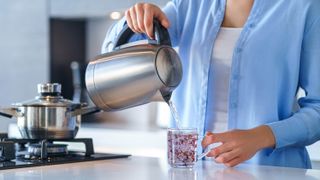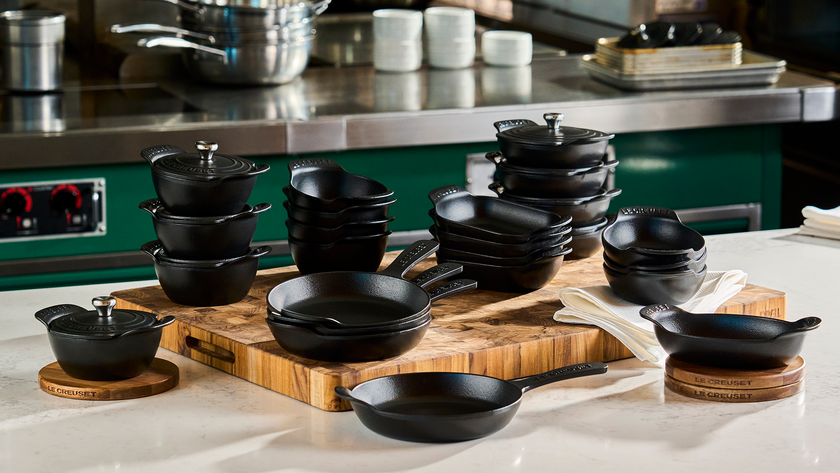I test appliances for a living and I’m surprised electric kettles aren’t more popular in the U.S.
Is your kitchen missing out on an electric kettle?

As the Homes Editor for Tom’s Guide, I’ve been testing and reviewing all kinds of appliances over the last six years. From the best washing machines, to the best vacuum cleaners and the best blenders, it’s safe to say I’ve seen it all. Plus, I’ve learnt a lot in the process. In fact, I test appliances for a living and here are my top washing machine tips.
But, to my surprise, there is one appliance which I rarely see in an American kitchen — one which I personally can’t live without. It’s not an expensive addition, and it’s one which is built with convenience in mind, so it’s truly confounding that this countertop appliance is M.I.A. Read on to see what I’m talking about and why every kitchen should have one.
Why aren’t electric kettles more popular?
The appliance I’m talking about is one of the best electric kettles. While there are indeed plenty of homes which are taking advantage of this device, it’s not nearly as popular as you’d imagine in the U.S. In fact, these are generally rarely spotted on the shelves in home department stores — you need to browse online to see the options available.

An electric kettle essentially boils water for you at the flick of a switch, taking minutes to do so. These appliances tend to feature a jug design with a flip-top or removable lid, and a gauge onside to show the internal capacity. It can be lifted cord-free from its base (which powers it) and poured out as soon as it reaches temperature. Using one of these essentially means you no longer have to wait for water to boil via the stove or the microwave. This makes an electric kettle an ideal solution if you often heat water for cooking or beverages.
There are two predominant types of electric kettle to choose from: standard and variable temperature. The latter is a more recent development. It essentially allows you to control the temperature more accurately, giving you more options than just boiling. This expands the versatility of this appliance, making it useful in more ways than one. For instance, if you’re a fan of herbal tea, a variable temperature kettle will give you access to the ideal brewing temperature. If you need to heat baby formula, a variable temperature kettle can give you a safe temperature to do so. There’s more possibilities than you’d think.

Gooseneck electric kettles are increasing in popularity as well. These feature a long and slender spout — a bit like a goose’s neck — which allows you to pour the water more slowly. This added control makes them ideal for slowly saturating aromatic tea leaves and coffee grounds — ultimately producing a better flavor and aroma. Most gooseneck kettles will offer variable temperature control, so you can program the best temperature to suit your tea and coffee, however there are standard single temperature designs available as well.
It’s important to flag that a gooseneck kettle will not be suitable for purposes where you require a large volume of water, such as for cooking. In this case, a standard jug-style kettle will be best. Gooseneck kettles do give you more accurate control over the water as you pour it, albeit at a slower rate.
It’s also worth noting that traditional kettles exist which can be heated via the stove — a half-way point between the two methods. However, these generally aren’t as efficient as electric options.
It’s hard to tell why electric kettles aren’t more popular in the U.S. Perhaps the increasing use of hot water taps is making them redundant, or perhaps consumers just aren’t aware of the benefits. If you’re in the latter category, here are some advantages to convince you.
Why should you get an electric kettle?
- Convenient — Hot water at the flick of a switch.
- Accurate — Variable temperature kettles give you accurate control of the temperature; ideal if you need a precise setting.
- Safe — Much safer versus heating water in a saucepan on the stove, out in the open.
- Fast — It’s quicker to heat water in an electric kettle versus on the stove or in the microwave.
- Portable — You can move the kettle around the house, so you could place it in a guest room for instance — no need for it to be situated in your kitchen. However, it should always be on a flat and stable surface.
- Energy efficient — An electric kettle will cut-out once the water reaches temperature, whereas it’s easy to leave the stove or microwave running for longer than necessary.
- Affordable — Electric kettles start from as little as $20, so there’s little excuse not to get one if you will make use of it. Keep in mind prices can go as high as $300, so always have a budget in mind when you browse.

There are few drawbacks to owning one of these appliances. However, you should be aware that the exterior of some electric kettles can grow hot in use, to the point where it’s a potential scalding hazard. This varies from kettle to kettle and is something which should be considered if you have young children in the house. Kettles should always be supervised in use to prevent accidents.
Electric kettles can also be quite noisy as they boil, so you may not want to use it first thing in the morning or last thing at night, unless you find a quiet model.
Otherwise, electric kettles really are something every kitchen needs. If you heat water regularly, these appliances can save you both time and effort, while giving you more control over the final temperature. And if you’re an avid tea and coffee drinker, a gooseneck kettle can give you access to aromas and flavors you never knew were possible. So why wouldn’t you have one?
For more appliance tips, tricks, and how-tos, check out our guides on best clothes dryers, juicer vs blender and 9 things you should never put in an air fryer.
Sign up to get the BEST of Tom's Guide direct to your inbox.
Get instant access to breaking news, the hottest reviews, great deals and helpful tips.

Katie Mortram used to be a Homes Editor for Tom's Guide, where she oversaw everything from kitchen appliances to gardening tools, as well as smart home tech. Specializing in providing expert advice for cleaning and home manintenance, she now works as Household Advice Editor for Good Housekeeping.
























